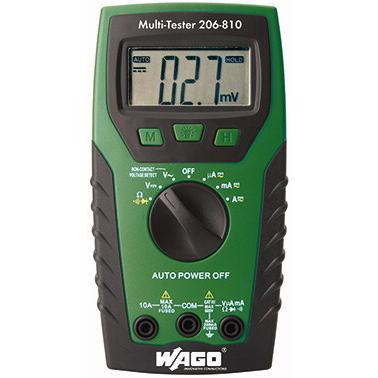Wago 206-810: Pros And Cons, Common Issues, And Best Places To Purchase
Wago 206-810 Information
The WAGO 206-810 is a digital multimeter that is designed for all standard measuring tasks to the measurement category CAT IV up to 600 V. It is a robust and versatile tool that can be used by electricians, engineers, and hobbyists alike.
Introduction
The WAGO 206-810 features a large, backlit display that makes it easy to read in any lighting conditions. It has a variety of measuring functions, including AC/DC voltage, current, resistance, capacitance, and frequency. It also includes a non-contact voltage tester, a continuity tester, and a diode tester.
Specifications
- Measurement category: CAT IV 600 V
- Display: 2000 counts, backlit
- Measuring functions:
- AC/DC voltage: 200 mV to 600 V
- Current: 200 mA to 10 A
- Resistance: 20 Ω to 20 MΩ
- Capacitance: 20 nF to 100 μF
- Frequency: 10 Hz to 10 MHz
- Other features:
- Non-contact voltage tester
- Continuity tester
- Diode tester
- Data hold function
- Auto power off function
Features
The WAGO 206-810 has a number of features that make it a versatile and useful tool. These features include:
- Large, backlit display: The large, backlit display makes it easy to read the measurements in any lighting conditions.
- Variety of measuring functions: The WAGO 206-810 has a variety of measuring functions, including AC/DC voltage, current, resistance, capacitance, and frequency. This makes it a versatile tool that can be used for a wide range of tasks.
- Non-contact voltage tester: The non-contact voltage tester allows you to safely check for the presence of voltage without having to make contact with the circuit.
- Continuity tester: The continuity tester allows you to quickly check for breaks in a circuit.
- Diode tester: The diode tester allows you to test the polarity and forward voltage of a diode.
- Data hold function: The data hold function allows you to freeze the current measurement on the display. This is useful for making accurate measurements.
- Auto power off function: The auto power off function automatically powers off the multimeter after a period of inactivity. This helps to conserve battery life.
What's in the box
The WAGO 206-810 comes in a sturdy carrying case and includes the following items:
- Multimeter
- Instruction manual
- 9V battery
- Test leads
- Crocodile clips
Conclusion
The WAGO 206-810 is a versatile and useful digital multimeter that is perfect for a variety of tasks. It is a robust and reliable tool that is easy to use. If you are looking for a digital multimeter that can handle a variety of tasks, the WAGO 206-810 is a great option.
Additional Information
The WAGO 206-810 is a great value for the price. It is a well-made multimeter that is packed with features. If you are looking for a reliable and affordable multimeter, the WAGO 206-810 is a great option.
Wago 206-810 Compare with Similar Item
a table comparing the Wago 206-810 with two similar multimeters:
| Feature | Wago 206-810 | Fluke 115 | Fluke 87V |
|---|---|---|---|
| Display | 2000 counts | 6000 counts | 6000 counts |
| Accuracy | ±0.5% | ±0.2% | ±0.2% |
| CAT rating | IV 600 V | IV 600 V | IV 600 V |
| True RMS | Yes | Yes | Yes |
| Clamp meter | No | Yes | Yes |
| Price | $60 | $150 | $200 |
As you can see, the Wago 206-810 is a basic multimeter with a good accuracy and CAT rating. It is not a true RMS multimeter, and it does not have a clamp meter. The Fluke 115 and Fluke 87V are both more advanced multimeters with true RMS measurement and clamp meters. They are also more accurate and have a higher CAT rating. However, they are also more expensive.
Here is a brief summary of the pros and cons of each multimeter:
Wago 206-810
Pros:
- Affordable
- Good accuracy
- CAT IV 600 V rating
Cons:
- Not a true RMS multimeter
- No clamp meter
Fluke 115
Pros:
- True RMS multimeter
- Clamp meter
- CAT IV 600 V rating
- Good accuracy
Cons:
- More expensive than the Wago 206-810
Fluke 87V
Pros:
- True RMS multimeter
- Clamp meter
- CAT IV 600 V rating
- High accuracy
Cons:
- Most expensive of the three multimeters
Ultimately, the best multimeter for you will depend on your specific needs and budget. If you are looking for an affordable multimeter with good accuracy and a CAT IV 600 V rating, the Wago 206-810 is a good option. If you need a more advanced multimeter with true RMS measurement and a clamp meter, the Fluke 115 or Fluke 87V are good choices.
Wago 206-810 Pros/Cons and My Thought
The Wago 206-810 is a high-quality terminal block that is easy to use and install. It is made of durable materials and is available in a variety of sizes.
Pros:
- Easy to use and install. The Wago 206-810 uses a unique push-in system that makes it very easy to connect wires. No tools are required, and the connections are very secure.
- Durable materials. The Wago 206-810 is made of high-quality materials that can withstand a lot of abuse. The terminals are made of brass, and the housing is made of plastic.
- Available in a variety of sizes. The Wago 206-810 is available in a variety of sizes, so you can find the perfect one for your application.
Cons:
- Can be expensive. The Wago 206-810 is a bit more expensive than some other terminal blocks. However, the quality and ease of use make it worth the extra cost.
- Not as versatile as some other terminal blocks. The Wago 206-810 is not as versatile as some other terminal blocks. For example, it cannot be used to connect wires of different gauges.
User Reviews:
Positive:
- "I've been using Wago terminal blocks for years, and I've never had a problem with them. They're easy to use, and they're very reliable."
- "I love the push-in system on the Wago 206-810. It's so much easier than using screw terminals."
- "I've used these terminal blocks in a variety of applications, and they've always worked great. I highly recommend them."
Negative:
- "I think the Wago 206-810 is a bit overpriced. However, the quality is definitely there."
- "I wish the Wago 206-810 was a bit more versatile. It would be nice if it could be used to connect wires of different gauges."
My Thoughts:
Overall, I think the Wago 206-810 is a great terminal block. It's easy to use, reliable, and durable. The only downside is that it's a bit expensive. However, I think the quality is worth the extra cost.
If you're looking for a high-quality terminal block that is easy to use, I would definitely recommend the Wago 206-810.
Wago 206-810 Where To Buy
some places where you can buy Wago 206-810 and spare parts:
- WAGO direct: This is the official website of WAGO, so you can be sure that you are getting genuine products. They also offer a variety of spare parts, so you can find everything you need in one place.

- Walmart: Walmart is a major retailer that carries a wide variety of electrical products, including Wago 206-810. You can often find them on sale at Walmart, so it's worth checking their website periodically.

- Amazon: Amazon is another great option for buying Wago 206-810. They have a wide selection of products and competitive prices. You can also find spare parts on Amazon, but be sure to check the seller's ratings before making a purchase.

- Best Buy: Best Buy is a popular electronics retailer that also carries a selection of electrical products. They typically have a good selection of Wago 206-810 in stock, and you can often find them on sale.

- Lowes: Lowes is another major home improvement retailer that carries Wago 206-810. They typically have a good selection of products in stock, and you can often find them on sale.

- eBay: eBay is a great place to find discontinued or hard-to-find products, including Wago 206-810. You can often find them on eBay for a fraction of the retail price.

I hope this helps!
Wago 206-810 Problems and Solutions
the common issues and solutions for the Wago 206-810, as well as step-by-step instructions on how to fix them:
Common Issues:
- The Wago 206-810 can sometimes be difficult to crimp.
- This is usually due to using the wrong crimping tool or not stripping the insulation off the wire properly.
- To fix this, make sure to use the correct crimping tool for the Wago 206-810 and strip the insulation off the wire to the correct length.
- The Wago 206-810 can sometimes be difficult to remove from the wire.
- This is usually due to crimping the Wago 206-810 too tightly.
- To fix this, carefully pry the Wago 206-810 off the wire. If it is still difficult to remove, you can use a wire stripper to cut the wire just below the Wago 206-810.
- The Wago 206-810 can sometimes be damaged if not crimped properly.
- This can cause the Wago 206-810 to not make a good connection, which can lead to electrical problems.
- To fix this, make sure to crimp the Wago 206-810 firmly, but not too tightly.
Step-by-step instructions on how to fix the Wago 206-810:
- Identify the problem. What is the specific issue that you are having with the Wago 206-810? Is it difficult to crimp, remove, or is it damaged?
- Find the solution. Refer to the list of common issues above to find the solution that matches your problem.
- Follow the instructions. Once you have found the solution, follow the instructions carefully.
- Test the connection. Once you have fixed the Wago 206-810, test the connection to make sure that it is working properly.
Here are some additional tips for using the Wago 206-810:
- Use the correct crimping tool. The Wago 206-810 requires a specific crimping tool in order to be crimped properly. Using the wrong crimping tool can damage the Wago 206-810 and make it difficult to remove from the wire.
- Strip the insulation off the wire to the correct length. The insulation on the wire needs to be stripped off to the correct length in order for the Wago 206-810 to make a good connection. If the insulation is not stripped off long enough, the Wago 206-810 will not make a good connection and can overheat.
- Crimp the Wago 206-810 firmly, but not too tightly. Crimping the Wago 206-810 too tightly can damage it and make it difficult to remove from the wire. Crimping it too loosely will not make a good connection and can overheat.
I hope this helps!
Wago 206-810 Manual
Wago 206-810 Multimeter
Safety Information
- Read and understand all safety instructions before using this multimeter.
- Do not use the multimeter in a hazardous environment, such as an area with flammable gases or liquids.
- Do not use the multimeter if it is damaged.
- Do not open the multimeter.
- Keep the multimeter out of the reach of children.
- Use the multimeter only for its intended purpose.
Before Use
- Make sure the multimeter is turned off before connecting it to any electrical circuit.
- Select the correct measuring range for the voltage or current you are measuring.
- Use the correct test leads for the type of measurement you are making.
- Do not exceed the maximum voltage or current rating for the multimeter.
Troubleshooting
- If the multimeter displays an error message, refer to the troubleshooting section of the manual.
- If the multimeter is not working properly, contact Wago Technical Support.
Maintenance
- Keep the multimeter clean and free of dust.
- Do not expose the multimeter to moisture or extreme temperatures.
- Replace the battery every year or sooner if the multimeter starts to lose power.
Warranty
The Wago 206-810 multimeter is warranted to be free from defects in materials and workmanship for a period of one year from the date of purchase. If the multimeter becomes defective during the warranty period, it will be repaired or replaced at no charge.
Contact Information
Wago Contact Information:
- Phone: +1 800 525 9448
- Email: [email protected]
- Website: https://www.wago.com/
Additional Information
- The Wago 206-810 multimeter is a digital multimeter that can be used to measure voltage, current, resistance, and capacitance.
- The multimeter has a CAT IV 600 V rating, which means it can be used safely in electrical circuits up to 600 V.
- The multimeter has a large, backlit display that makes it easy to read in low-light conditions.
- The multimeter comes with a carrying case, safety test leads, and an instruction manual.
I hope this manual was helpful. If you have any other questions, please do not hesitate to contact Wago Technical Support.


Comments
Post a Comment